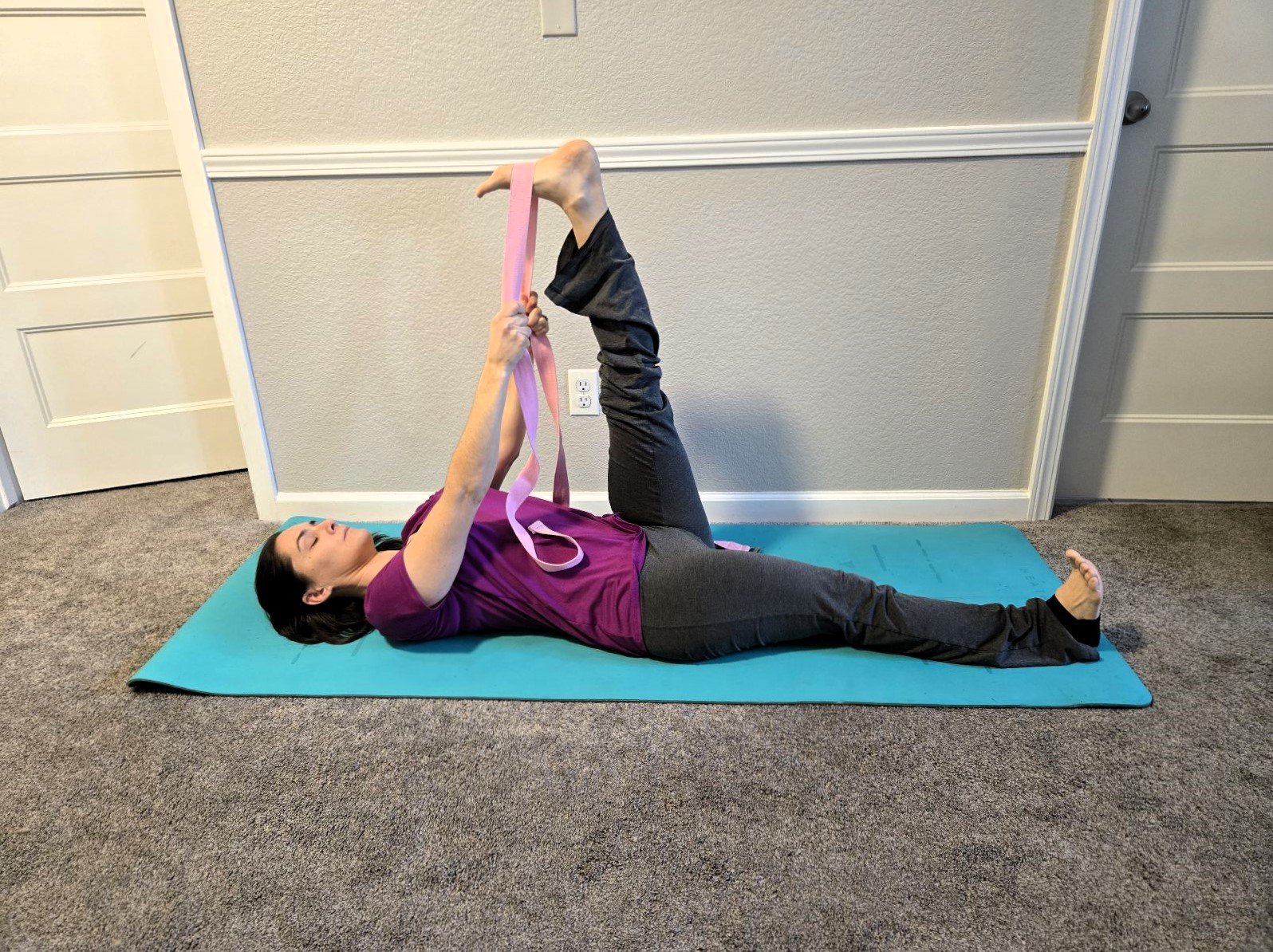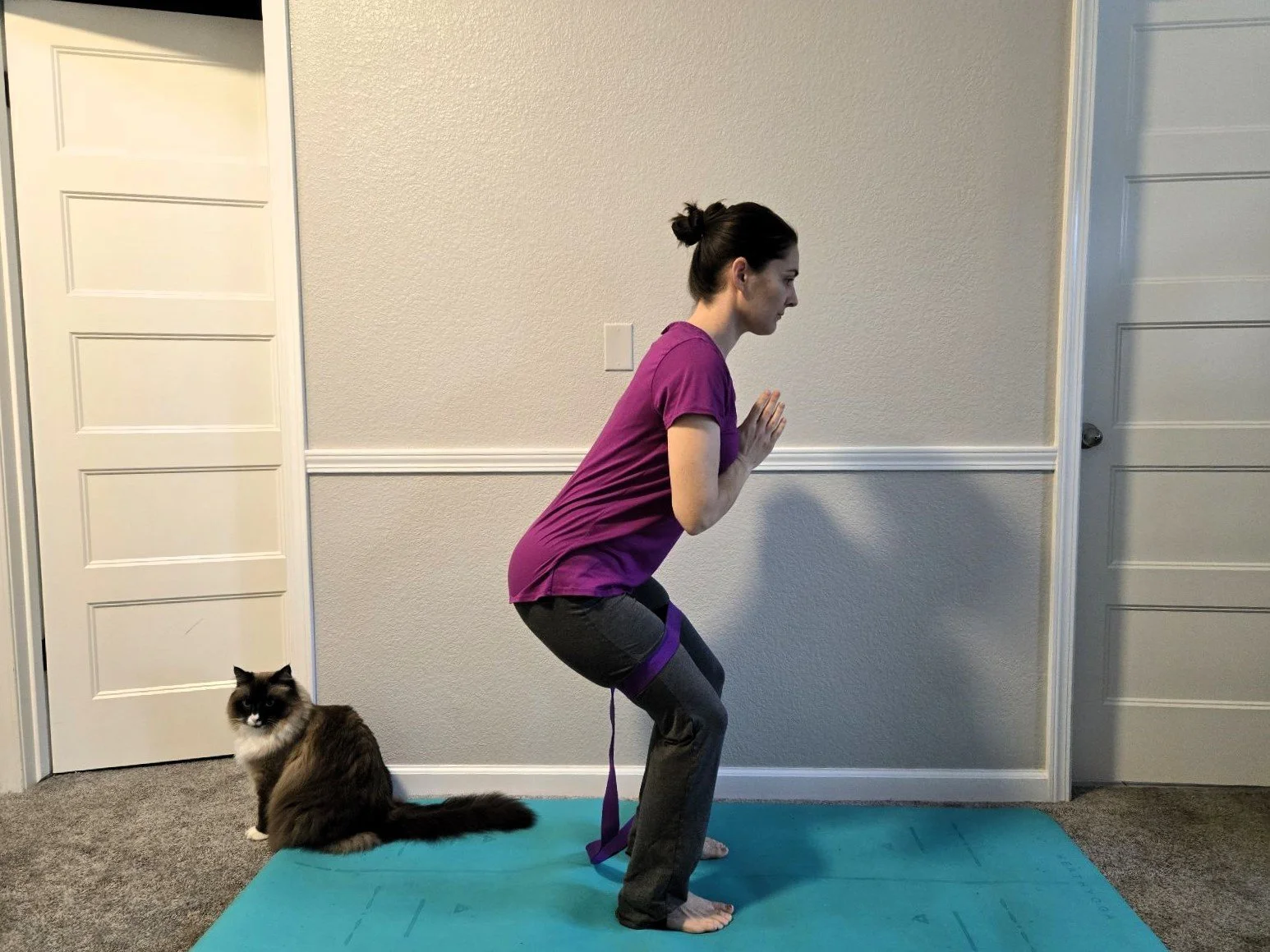How to Improve Symmetry with Yoga Props: Yoga Straps
/Body asymmetries can challenge your balance, stability, and mobility and cause bodily pain and emotional anxiety. Conditions like scoliosis, leg length discrepancy, or joint replacements can cause significant and painful body asymmetries, which in turn can disrupt the nervous system and emotional balance.
Body alignment is important for several reasons: It can help prevent injuries, improve muscle mobility and organ function, and reduce bodily pain. Incorporating practices like yoga, Pilates, regular stretching, and alignment mindfulness into your routine can help you improve your body symmetry and reap these benefits.
In this post—the third in a series detailing how to incorporate props in your yoga practice to improve your body symmetry and alignment—I introduce ways to use yoga straps.
What is a yoga strap?
A yoga strap is a long, narrow piece of fabric—made from materials such as cotton, nylon, or leather—that can be used while in yoga poses and practices to enhance flexibility, improve balance, and assist in poses that might be challenging to achieve without additional support. Ways in which they can be used include the following:
Deepening stretches: By looping a strap around your feet or hands, you can extend your reach and deepen stretches in poses like Reclined Hand-to-Big-Toe Pose (Supta Padangusthasana).
Providing support: Straps can be used to support your body in poses like Chair Pose (Utkatasana) or Camel Pose (Ustrasana), helping to maintain proper alignment and reduce the risk of injury.
Increasing or evening out your range of motion: By gradually using a strap to regulate the distance between your hands, feet, or other body parts in a pose, you can gradually improve or stabilize your range of motion. I use a long strap around my upper back and shoulders to help even out my sides.
Introducing more symmetry: A folded-up strap can be used under one foot to introduce more symmetry or resistance on a shorter or less aware leg or foot.
Overall, yoga straps are versatile tools that can help you deepen your practice and achieve a greater sense of balance and flexibility.
Which straps to choose?
While yoga straps can be valuable tools in your practice, choosing the right yoga strap depends on your individual needs and preferences. Here are some factors to consider:
Length: The length of the strap should be appropriate for the poses you plan to practice. They come in 6-, 8-, and 10-foot lengths. A longer strap may be necessary for poses like Reclined Hand-to-Big-Toe Pose, especially for tall people with long legs, while a shorter strap might be better suited for poses like Chair Pose where it is being used more for support or resistance.
Material: The material of the strap can affect its durability, comfort, and grip. Cotton straps are a popular choice for their softness and breathability, while nylon straps are often more durable and resistant to moisture. Leather straps are typically the most durable but are less flexible. They also come with different buckles: some are plastic cinch, others are D rings, and others use a metal interlocking bar.
Width: The width of the strap can also affect its comfort and support. A wider strap may provide more support in poses like Reclined Hand-to-Big-Toe Pose, while a narrower strap may be more suitable for poses that require a finer grip or for a strap to go around a smaller body part, like the toes.
Grip: Some yoga straps have textured or non-slip surfaces to improve grip and prevent slipping. This can be particularly helpful in poses where your hands or feet may be sweaty.
Price: Yoga straps are available in a wide range of prices. Consider your budget and the frequency of your practice when choosing one.
Ultimately, the best way to choose a yoga strap is to try out different options and see what works best for you. Certain yoga lineages, like Iyengar Yoga, employ yoga straps regularly and of differing lengths in the same practice. Experiment with different lengths, materials, widths, and class type to find a strap and practice that feels most comfortable and supportive.
What do I use? It depends on the pose I am doing. I use cotton straps in every length with each type of buckle. However, my most commonly used straps are 6- and 12-foot straps with D-rings.
Here are some effective yoga poses in which straps enhance symmetry:
Reclined Hand-to-Big-Toe Pose with a Strap: Use a strap around the foot that is raised toward the ceiling. Notice the flexibility and location of the legs. Are the knees pointing the same direction? Do they line up in the same way on both sides? Look for symmetry and use the strap to guide each side into greater alignment with the ankles over the knees over the hips.
Chair Pose: Use a strap around the thighs to make the them more parallel to each other and centered on the midline. You can also press out into the strap to provide additional strengthening of the outer hips.
Cross-Strap Shoulder Traction: My Yoga for Scoliosis teacher Elise Browning Miller taught me this. While standing in Mountain Pose (Tadasana), use a long belt centered across the base of your shoulder blades and place the ends of the straps over the shoulders. Then cross the belts behind you, holding the straps in the opposite hands of the shoulders they are laying over. Pull down with the hands and try to align the tops of the shoulders, while you broaden through the front of the chest.
Here are some tips for using yoga straps effectively:
Start slowly: If you’re new to using yoga straps, start with simple poses and gradually increase the intensity and complexity as you become more comfortable with them. Also, don’t be afraid to ask your instructor how best to use them in a particular pose.
Listen to your body: Always listen to your body and avoid pushing yourself beyond your limits. If you feel pain, stop. Using props should help you receive more feedback in a pose and can help introduce more awareness in a pose, helping you stay within your body’s limits.
Adjust the strap length: The length of the strap can be adjusted to suit your individual needs. Experiment with different lengths and materials to find what works best for you.
Combine with other props: Yoga straps can be used in combination with other props, such as blocks or blankets, to create a more supportive and effective practice. For example, using a block between your thighs with a strap wrapped around them in Chair Pose can be more supportive and better keep your legs in alignment.
By following these tips, you can begin to effectively use yoga straps to enhance your alignment and body symmetry.
Want to learn more about using props to improve symmetry in your yoga practice? Check out my other posts in the series:
Yoga Mats
Yoga Blocks





